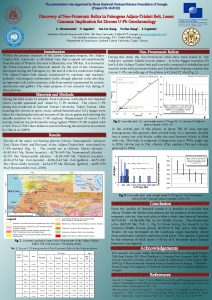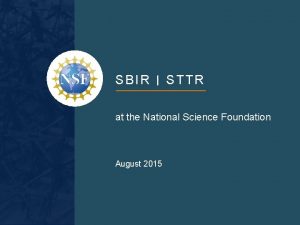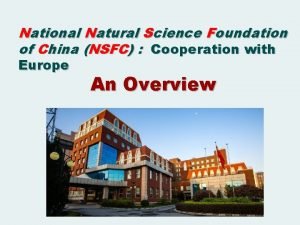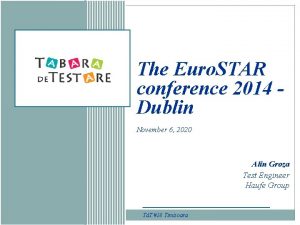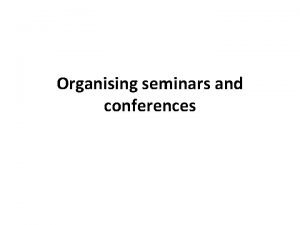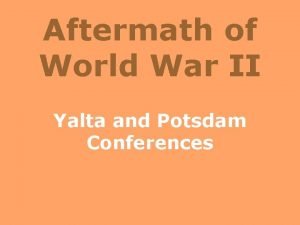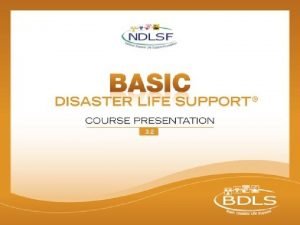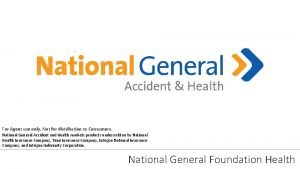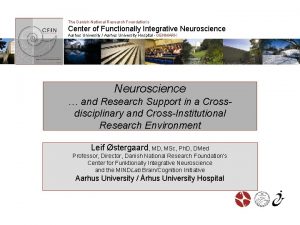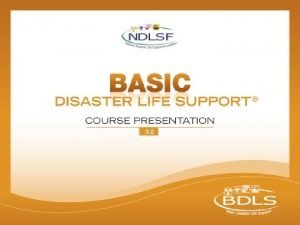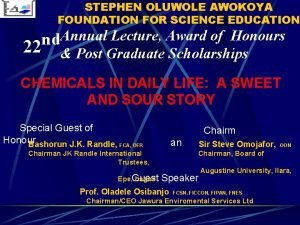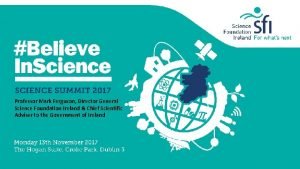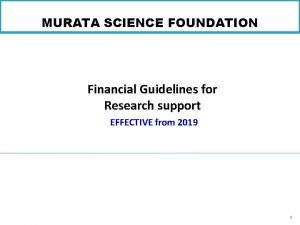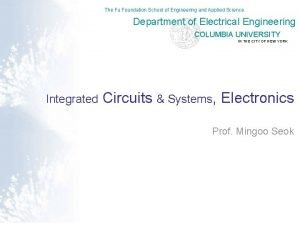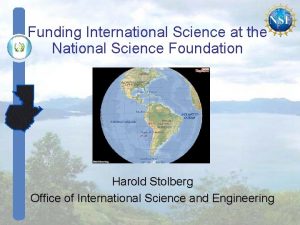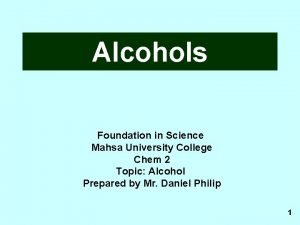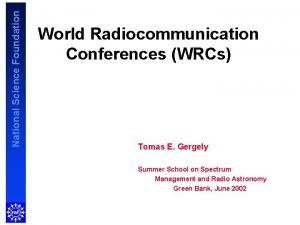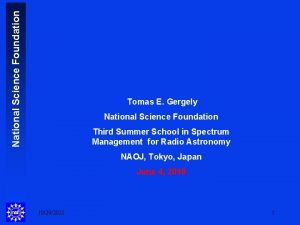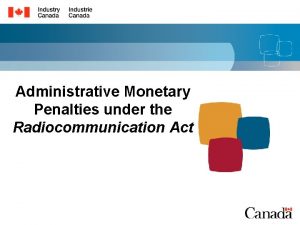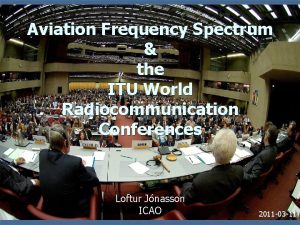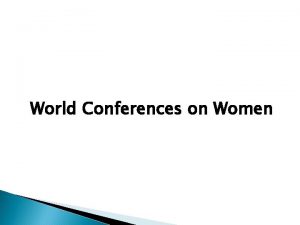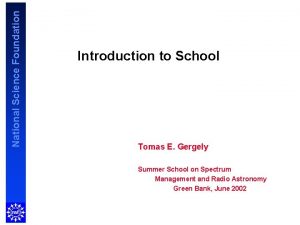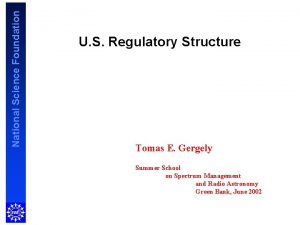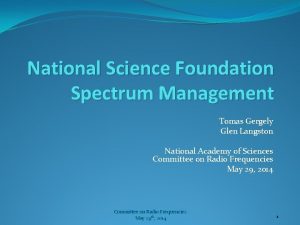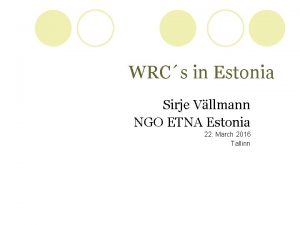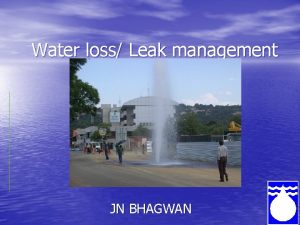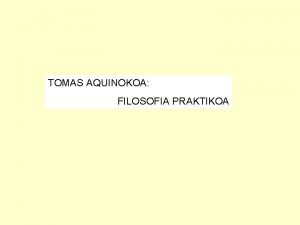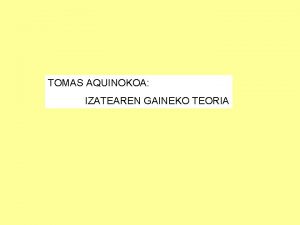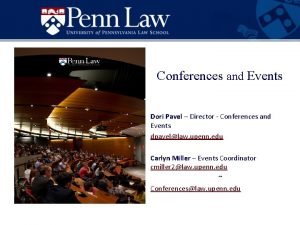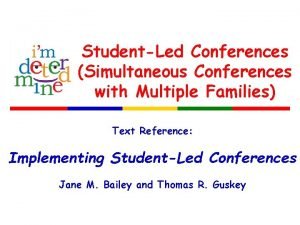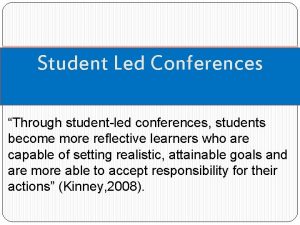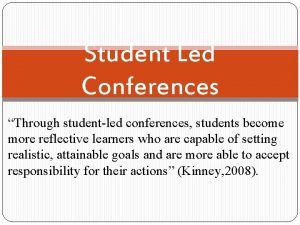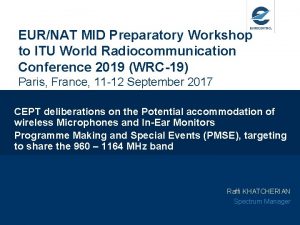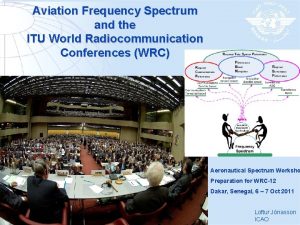National Science Foundation World Radiocommunication Conferences WRCs Tomas























- Slides: 23

National Science Foundation World Radiocommunication Conferences (WRCs) Tomas E. Gergely Summer School on Spectrum Management and Radio Astronomy Mitaka, Tokyo, Japan June 2010

National Science Foundation WRCs: Introduction WRCs Are a Big Deal! v. WRC-07 attended by: § over 2800 delegates § from 164 countries § and 104 observers from member organizations ëConsidered over 400 documents 23 February 2021 2

National Science Foundation FFor a Feel of a WRC (WRC-97) as Experienced by An Astronomer, see: http: //dsnra. jpl. nasa. gov/freq_man/wrc 97. html 23 February 2021 3

National Science Foundation The ITU Framework FInternational uses of the radio spectrum are regulated by the International Telecommunication Union (ITU), (a specialized agency of the United Nations) through the Radio Regulations The International Table of Allocations is part of the Radio Regulations (Article 5). At present, within the ITU, radiocommunication is considered to encompass the spectrum below 3 000 GHz, but spectrum allocations cover only up to 275 GHz. WRC-12 will revise footnote 5. 565 that deals with passive uses of the 275 – 1000 GHz range, to cover up to 3 000 GHz Countries are sovereign with regard to the uses and the regulation of the radio spectrum within national borders and are under no obligation to adopt or follow the International Table of Allocations inside their territory, but mostly do so, out of convenience. The Radio Regulations are an international treaty that covers all aspects of radiocommunications, in particular, the use of the radio-frequency spectrum by all radio(communication) services and the geostationary orbit. F F 23 February 2021 4

National Science Foundation How Can WRCs Impact Radio Astronomy? FDirectly Through: 4 Allocations: ~In-Band sharing ~Adjacent band allocations (satellite downlinks) ~Footnotes ~Establishing (or not establishing) standards (e. g. spurious emissions, frequency tolerances, etc. ) ~Other regulations (e. g. coordination requirements ) FMandating Studies that may affect the status of radio astronomy in various bands FOther Regulations (e. g. data required for the registration of Radio Observatories, Earth Stations, etc. ) FPlacing Radio Astronomy issues (or related issues) on the agenda of a future WRC 23 February 2021 5

National Science Foundation How Do WRCs Work: Agendas and Proposals F The scope of each WRC is limited by an Agenda F Each WRC develops and formally adopts a draft Agenda (contained in a F F F Resolution) for the next conference, and a provisional agenda for the following one. Agendas may contain many unrelated items, e. g. : AIs 1. 6 and 1. 8 (WRC-12) ë 1. 6 Revision of footnote RR 5. 565 and extending it up to 3 000 GHz ë 1. 8 Sharing between the fixed service and other services (including the RAS) in the 71 -238 GHz range ; The draft Agenda for each WRC must be formally approved by the ITU Administrative Council, which meets annually. Once approved by the Council, the Agenda is submitted to Member States for final adoption, and is finalised about 12 months after the previous WRC developed it. An issue that is not on the Agenda cannot be treated, so often there is considerable competition (fight) among items wanting a place on the Agenda. F WRCs work by considering Proposals, that may be submitted only by Members (Administrations ) in good standing (ratified the convention and paid their dues) F The deadline for submitting proposals is (usually) set six months prior to the beginning of the WRC (and this deadline is often ignored) 23 February 2021 6

National Science Foundation Proposals: An Example MOD USA/38/2 1 429 -1 452 FIXED MOBILE except aeronautical mobile 5. 341 5. 342 ADD 5. MSSDN ADD 5. MSSCOOR 1 429 -1 452 FIXED MOBILE 5. 343 5. 341 ADD 5. MSSDN ADD 5. MSSCOOR Reasons: To provide necessary allocations for non-GSO MSS feeder links (Earth-to-space) and (space to-Earth) in support of existing non-GSO MSS service link allocations below 1 GHz while ensuring protection of currently allocated services. ADD USA/38/6 5. MSSDN Additional allocation: The band 1 430 -1 432 MHz is also allocated on a primary basis to the mobile-satellite service (space-to-Earth), limited to feeder links for non-geostationary systems in the mobile-satellite service with service links below 1 GHz. In order to protect the radio astronomy service in the 1 400 -1 427 MHz band, the aggregate power flux‑density radiated by all space stations produced in the 1 400 -1 427 MHz band shall not exceed the level of – 180 d. B(W/m 2) in a 27 MHz band a level of – 196 d. B(W/m 2) in any 20 k. Hz portion of the 1 400 -1 427 MHz band, at the site of any radio astronomy station for more than 2% of the time. 23 February 2021 7

National Science Foundation STRUCTURE OF WRC-07 PLENARY (Chairman) Com 6 Future Agendas Revision of Res and Recs Com 1 Steering Com 2 Credentials Com 3 Budget Com 7 Editorial COM 4 COM 5 13 Agenda Items 14 Agenda Items 23 February 2021 8

National Science Foundation How Do WRCs Work: Mechanics FCompromise is sought to the maximum extent possible, votes are avoided as much as possible FOne country, one vote rule favors the formation of (regional) blocs: CEPT, APT, CITEL, Arab Bloc, etc. FDelegations, representing members e. g. IUCAF), work by trying to influence Administrations by: • • Lobbying Distributing Information papers Addressing the Floor, when allowed to do so Any other way possible, (some legal, some less so) FRadio Astronomers participate through: • National Delegations (participate in developing national positions, delegation meetings, as spokespersons, etc. , they are however, bound by national positions) • IUCAF (free to lobby, not bound by [but in most cases also unable to] influence national positions) • Most countries do not allow simultaneous participation in national and Member delegations, but some do. 23 February 2021 9

National Science Foundation The Mechanics of WRCs FProposals are attributed to the various committees (or subcommittees) and are introduced there in some detail FSubcommittees or drafting groups are formed, until a manageable size of interested people is reached (sometimes nested 5 -6 levels deep) FConsensus is sought in the subgroups, often many meetings may be necessary to resolve an issue (e. g. to resolve the GLONASS related issue at WRC-07 (Res. 739), six meetings were necessary) If consensus is reached, the consensus proposal is elevated to the parent group for approval (and so on, until it reaches the plenary) If consensus is impossible to reach, Chairman of parent group is informed and takes over Votes are taken only as a last recourse, when all attempts at reaching consensus failed Often there is only a partial resolution of an issue, with resolutions for further studies, and the issue may be revisited at the next WRC Much (but not all!) Depends on the chairpersons’ ability to conduct the meetings and force consensus One consequence of this procedure is that the most difficult problems are left to the end of the WRC, and end up treated in large groups F F F 23 February 2021 10

National Science Foundation Consensus Reached : Mm-wave Allocations (WRC-00) F F F 23 February 2021 REASONS FOR SUCCESS: Systems Above 71 GHz Are Under Development, But Are Not Yet Operational, So No Costly Assets Needed to Be Relocated Astronomers coordinated proposals very closely and carefully during the process leading up to the WRC. This resulted in nearly identical proposals by the three large regional groups within the ITU (CITEL, CEPT and APT) Astronomy Proposals Were Also Carefully Coordinated With Remote Sensing Community (and Amateurs) Flexibility Shown By Astronomy Community In Developing Proposals Active Services Distracted By Many Other WRC Related Concerns Few Active Commercial Requirements in This Spectral Region Yet (But Situation Changing Rapidly, e. g. FCC Push to Commercialize 90 - 94 GHz ) 11

National Science Foundation WRC Output F The output of a WRC is contained in the “Final Acts”, a treaty level document, that usually has to be ratified, by each country’s parliamentary process. Administrations may exempt themselves from complying with some provisions of the Final Acts, by taking a “reservation”. Reservations are appended to the Final Acts. F F 23 February 2021 12

National Science Foundation WRC-12 AI 1. 6 - The Item of Major Interest to Radio Astronomy F Res. 950 - Revision of footnote 5. 565, based on ITU-R studies F 4 Revise the listing of bands in the 275 - 1000 GHz range, currently in the footnote 4 Extend the range of the footnote, to cover up to 3000 GHz Res. 955 - Consider possible procedures for freespace optical links, based on ITU-R studies 23 February 2021 13

National Science Foundation (Some) Other WRC-12 Agenda Items of Interest to Radio Astronomy F AI 1. 4. “…. to consider, …. further regulatory measures to facilitate introduction of new aeronautical mobile (R) service (AM(R)S) systems in the bands … 5 000 -5 030 MHz” Ø Issue: airborne transmitters may be operating next to the primary 4990 -5000 MHz radio astronomy band F AI 1. 18”… extending the existing …radiodetermination-satellite service (space -to-Earth) allocations in the band 2 483. 5 -2 500 MHz in order to make a global primary allocation, and determine the necessary regulatory provisions…. ” Ø Issue: 2 nd harmonic of downlink falls on 4990 -5000 MHz RA band, currently subject to footnote RR 5. 402, that urges protection of RA F AI 1. 21. “to consider a primary allocation to the radiolocation service in the band 15. 4 -15. 7 GHz…” Ø Issue: Strong, possibly airborne transmitters operating next to the 15. 35 -15. 4 GHz passive band F AI 1. 20 “spectrum identification for gateway links for high altitude platform stations (HAPS) in the range 5 850 -7 075 MHz in order to support operations in the fixed and mobile services” Ø Issue: Potential interference with observations of the 6650 -6675. 2 MHz band, identified for observations of the 6668 MHz methanol line

National Science Foundation AIs that May Impact Radio Astronomy FAI 1. 2 “Taking into account ITU-R studies …. to take appropriate action with a view to enhancing the international regulatory framework” FAI 1. 8 “ to consider the progress of ITU‑R studies concerning the technical and regulatory issues relative to the fixed service in the bands between 71 GHz and 238 GHz…” FAI 1. 19 “ to consider regulatory measures and their relevance, in order to enable the introduction of software-defined radio and cognitive radio systems” FAI 1. 25 to consider possible additional allocations to the mobilesatellite service FAI 8. 2 “to recommend …. items for inclusion in the agenda for the next WRC” - (possibly 2015) ë Are There any Astronomy/Science Related Requirements? If so, it’s not too soon to start work to place it on the Agenda.

National Science Foundation WRC Preparations: The International Process FPreparations for the (next) WRC start as soon as one ends. They are channeled towards the Conference Preparatory Meeting (CPM), that prepares a report containing the “technical” basis for the various agenda items FFirst CPM meeting, held immediately after the WRC, determines the content and organization of the CPM report, based on the WRC agenda Studies, often mandated in WRC resolutions are carried out (or not!) In the various study groups “Responsible” SGs draft CPM text, with input from other “interested” SGs Draft CPM report is put together by chapter rapporteurs Second CPM meeting held, usually 6 months before the WRC, to finalize CPM report CPM meetings have become very political and often serve to stake out preliminary positions for the WRC, rather than attempting to solve technical issues F F F 23 February 2021 16

National Science Foundation REFERENCES Kuiper, T. B. H. , ”WRC-97, Geneva, Nov. 2 -7”, at: http: //dsnra. jpl. nasa. gov/freq_man/wrc 97. html ITU related : Websites of the International Telecommunication Union (ITU): http: //www. itu. int/en/pages/default. aspx http: //www. itu. int/ITU-R/index. asp? category=conferences&rlink=wrc&lang=en § § Radio Astronomy at WRC’s: F Findlay, J. W. “IUCAF and Frequencies for Radio Astronomy”, in IAU Colloquium No. F 112 (D. L. Crawford, ed. ), Light Pollution, Radio Interference and Space Debris, 1991, Astr. Soc. Pacific Conf. Ser. , Vol. 17 Robinson, B. “Frequency Allocation: The First Forty Years”, Ann. Rev. Astron. Astrophys. , 1999, 37, 65 23 February 2021 17

National Science Foundation Back Up Slides 18

National Science Foundation WRCs: History (1) F 1865 First International Telegraph Convention signed in Paris by the 20 founding members; International Telegraph Union (ITU) established F 1906 First International Radiotelegraph Conference held in Berlin signs the first International Radiotelegraph Convention. The annex to this Convention contained the first regulations governing wireless telegraphy. Expanded and revised by numerous radio conferences, these are now known as the Radio Regulations F 1927 Washington D. C. Conference held to establish the International Radio Consultative Committee (CCIR) F 1932 Madrid Conference, decides to combine the International Telegraph Convention of 1865 and the International Radiotelegraph Convention of 1906 to form the International Telecommunication Convention, and to change the name of the Union to International Telecommunication Union. F Atlantic City Conference held with the aim of developing and modernizing the 1947 organization. The ITU becomes a UN specialized agency. The International Frequency Registration Board (IFRB) is established to coordinate the increasingly complicated task of managing the radio-frequency spectrum. The Table of Frequency Allocations, introduced in 1912, is declared mandatory. F 1959 CCIR sets up a study group responsible for studying space radiocommunication. F 1963 Geneva, Extraordinary Administrative Conference for space communications held to allocate frequencies to the various space services for the first time. 23 February 2021 19

National Science Foundation WRCs: History (2) New Regulations (in Particular, Frequency Allocations) Are Adopted at and by WRCs, and Are Incorporated Into the RR F Before 1993 WRCs came in two flavors: Specialized and GWARCs, and were held on an “as needed” basis F WRCs held between 1979 and 1992: • 1979 G-WARC (WARC-79) • 1983 Mobile WARC (WARC Mob-83) • 1984 HFBC WARC (HFBC-84) • 1985 WARC on Geostationary Orbit Use (ORB-85) • 1987 HFBC WRC (HFBC-87) • 1987 Mobile WARC (WARC Mob-87) • 1988 WARC on Geostationary Orbit Use (ORB-85) • 1992 WARC for Dealing with Allocations in Certain Parts of the Spectrum (WARC-92) 23 February 2021 F 1993 – 2003 WRCs Have Been F F Held Regularly, every 2 -3 years. I With Broad Agendas, with no Content Restriction (Though Administrations Attempt to Control the Number of Agenda Items) WRCs held since 1993: • • • Geneva 1995 (WRC-95) Geneva 1997 (WRC-97) Istanbul 2000 (WRC-00) Geneva 2003 (WRC-03) Geneva 2007 (WRC-07) 20

National Science Foundation Radio Astronomy at WRCs F 1950 Zurich URSI GA Need to have frequency bands reserved for radio astronomy discussed for the first time. F 1959 WARC, Geneva, Ch. Seeger, RA Representative (4 months, at $15 per diem!): Radio Astronomy recognized as a “service” Ø Protection provided to the HI line in the RR Ø Footnote protection provided to other bands Ø Further discussions and “studies Ø ” at Space WARC-63 Ø IUCAF formed, to prepare RA positions for WARC-63 F 1963 Space WARC, Geneva: Ø IUCAF participates, for the first time Ø OH line discovery announced, secondary allocations to main OH lines made F 1971 WARC-ST, Geneva: Ø Allocations up to 275 GHz Ø Table allocations to RA: OH (1665 & 1667 MHz), NH 3 (23. 7 GHz) and HCN(86. 3 and 88. 6 GHz) Ø Footnote allocations to 7 other lines Ø Recommendation on the Shielded Area of the Moon Reserved for RA F 1979 G-WARC, Geneva, 14 RA Representatives for various periods, 6 weeks Ø 16 bands allocated in the Table to RA, up to 116 GHz Ø 18 bands allocated by footnote above 140 GHz 23 February 2021 21 Ø Recommendation 66 approved, first concerns about out-of-band emissions

National Science Foundation Radio Astronomy at WRCs (2) F F F F 1987 Mob-WARC, Geneva, 1 RA Representative Ø Limited Impact on RA 1988 WARC-Orb, Geneva, 1 RA Representative 1992 WARC, Malaga-Torremolinos, 9 RA Representatives (6 IUCAF, 3 on Nat. Delegations): Ø 1610 -1626. 5 MHz allocated to MSS (IRIDIUM), 1612 MHz RA allocation upgraded to primary, RR 733 E approved 1993 WRC, Geneva, 2 RA Representatives, both IUCAF Ø Agenda and timing of future conferences, no substantive issues 1995 WRC, Geneva, 9 RA Representatives (5 IUCAF, 4 on National Delegations Ø Frequencies allocated to Teledesic (Broad-band systems), various footnotes protecting RA approved Radio Regs “simplified” 1997 WRC, Geneva, 14 RA Representatives (7 IUCAF, 7 on National Delegations) Ø First Appearance of Aggregate interference pfd’s (and epfd concept), FSS allocated to 40. 5 -42. 5 GHz Ø Recommendation 66 revised Ø 15 GHz radio astronomy allocation is protected to specific pfd level Ø Protection of RA at 42 GHz is addressed 2000 WRC, Istanbul, 17 RA representatives (3 IUCAF, 14 on National Delegations) Ø 71 - 275 GHz spectrum realigned, to accommodate passive needs Ø 3 RA bands protected to specific pfd levels from adjacent satellite downlinks) Ø 42 GHz RA allocations protected 2003 WRC, Geneva, 17 RA representatives ( 4 IUCAF, 13 on National Delegations) 4 5 GHz RA allocation protected from RNSS (Galileo) emissions 4 1. 4 GHz conditional satellite allocations 23 February 2021 22 4 Non-mandatory consultation between RA observatories and satellite operators if unwanted emission exceed 769 levels.

National Science Foundation Distance at which Rec. ITU-R RA. 769 is met, under near worst case assumptions (see A. Clegg - US WP 7 D/71) 23
 Shota rustaveli national science foundation
Shota rustaveli national science foundation Nsf sbir deadlines
Nsf sbir deadlines National science foundation of china
National science foundation of china Star conferences inc
Star conferences inc Mice
Mice Who attended all three round table conference
Who attended all three round table conference Organising a seminar
Organising a seminar As a result of the yalta and potsdam conferences, ________.
As a result of the yalta and potsdam conferences, ________. My favorite subject is
My favorite subject is Shallow pad foundation
Shallow pad foundation Composition of urine
Composition of urine National education foundation nef
National education foundation nef National disaster life support foundation
National disaster life support foundation Ngic 888-781-0585
Ngic 888-781-0585 Danish national research foundation
Danish national research foundation National disaster life support foundation
National disaster life support foundation Stephen oluwole awokoya foundation for science education
Stephen oluwole awokoya foundation for science education Sfi research professorship
Sfi research professorship Murata science foundation
Murata science foundation Israel science foundation
Israel science foundation Science foundation arizona
Science foundation arizona Fu foundation school of engineering and applied science
Fu foundation school of engineering and applied science Nsf oise
Nsf oise Foundation in science mahsa
Foundation in science mahsa
